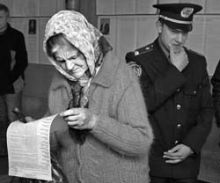More than enough food for thought for politicians, experts, and the electorate. The first principal factor is the polarization of the Ukrainian electorate manifesting itself in the first round. Some 80% voters backed the two leading presidential candidates and Ukraine became once again divided politically as well as geographically. The closing part of the first round of the election campaign ended in accordance with the runoff logic, with both leaders fighting a deadly duel, trying to win over the other potential candidates’ electorate.
The worst to suffer from all this were the left party leaders. A great many potentially left-minded voters cast their ballots for Viktor Yanukovych in the first round. The Communist Party’s fiasco in the 2004 presidential campaign is a very heavy blow to its position in the next parliamentary elections.
Obviously the winner of this campaign will be named in the second round. The question is who won the first one. The Central Election Committee’s preliminary estimates point to Viktor Yanukovych; ditto the turnouts of several exit polls. Yet the exit poll carried out by the Kyiv International Institute for Social Studies (KMIS) and by the Razumkov Center, using anonymous polling techniques, shows that Viktor Yushchenko is more than 6% ahead. Whereas Yanukovych’s campaigners may suspect Razumkov of adopting a biased attitude in Yushchenko’s favor and working for his campaign, KMIS has an unblemished professional reputation. Yushchenko’s campaign HQ declared that they objected to the CEC official turnout statistics and offered their own, based on a parallel vote count.
Yanukovych’s team, in turn, applied a mirror reflection technique, claiming that the opposition was resorting to falsifications and transgressing the election law. Accordingly, they accused Yushchenko’s team of such transgressions in precisely those regions where Yushchenko was undeniably ahead of Yanukovych.
From a formal political point of view, the results of the first round can be described as a game ending technically in a tie, meaning that the situation remains strategically in suspense. Viktor Yushchenko team has found itself faced with the difficult political dilemma of recognizing or contesting the first round’s official turnout. On the one hand, even the preliminary estimates of the first round indicate that Our Ukraine leader stands a fair chance in the runoff. Yet acknowledging these results means preserving all those problem issues in the campaign organization and vote count discovered in the first round.
The Force of the People Coalition may resort to the usual method of mass actions of protest, demanding official recognition of Viktor Yushchenko’s victory in the first round. In which case Ukraine would suffer playing out the Abkhaz scenario, meaning that the election process would come to a screeching halt after the first tour and this country would find itself gripped by a major political crisis.
Another campaign trend is winning over to one’s side the voters who backed the left parties and so-called low-rating candidates in the first round. Most those who voted for Petro Symonenko and Nina Vitrenko could vote for Viktor Yanukovych in the second round. Viktor Yushchenko, in turn, could count on a major part of those originally supporting Moroz, Kinakh, Chernovetsky, and several other candidates. Our Ukraine’s leader may also have tangible support from all those who could not cast their ballots on October 31, due to problems with voters’ lists.
The first round demonstrated the campaign warfare logic. One can only hope that the runoff will show which of the leading candidates is better equipped to play the national leader’s role and to overcome all those regional-political-division trends that made themselves obvious during the presidential campaign.







